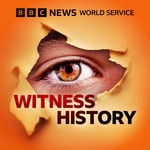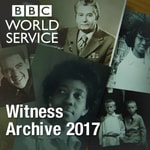Witness History – Détails, épisodes et analyse
Détails du podcast
Informations techniques et générales issues du flux RSS du podcast.

Witness History
BBC World Service
Fréquence : 1 épisode/1j. Total Éps: 2000

Eye-witness accounts brought to life by archive. Witness History is for those fascinated by the past. We take you to the events that have shaped our world through the eyes of the people who were there. For nine minutes every day, we take you back in time and all over the world, to examine wars, coups, scientific discoveries, cultural moments and much more. Recent episodes explore everything from the death of Adolf Hitler, the first spacewalk and the making of the movie Jaws, to celebrity tortoise Lonesome George, the Kobe earthquake and the invention of superglue. We look at the lives of some of the most famous leaders, artists, scientists and personalities in history, including: Eva Peron – Argentina’s Evita; President Ronald Reagan and his famous ‘tear down this wall’ speech; Thomas Keneally on why he wrote Schindler’s List; and Jacques Derrida, France’s ‘rock star’ philosopher. You can learn all about fascinating and surprising stories, such as the civil rights swimming protest; the disastrous D-Day rehearsal ; and the death of one of the world’s oldest languages.
Classements récents
Dernières positions dans les classements Apple Podcasts et Spotify.
Apple Podcasts
🇨🇦 Canada - personalJournals
06/08/2025#16🇬🇧 Grande Bretagne - personalJournals
06/08/2025#18🇩🇪 Allemagne - personalJournals
06/08/2025#24🇺🇸 États-Unis - personalJournals
06/08/2025#28🇫🇷 France - personalJournals
06/08/2025#35🇨🇦 Canada - personalJournals
05/08/2025#21🇬🇧 Grande Bretagne - personalJournals
05/08/2025#18🇩🇪 Allemagne - personalJournals
05/08/2025#39🇺🇸 États-Unis - personalJournals
05/08/2025#29🇨🇦 Canada - personalJournals
04/08/2025#25
Spotify
Aucun classement récent disponible
Liens partagés entre épisodes et podcasts
Liens présents dans les descriptions d'épisodes et autres podcasts les utilisant également.
See allQualité et score du flux RSS
Évaluation technique de la qualité et de la structure du flux RSS.
See allScore global : 39%
Historique des publications
Répartition mensuelle des publications d'épisodes au fil des années.
The woman who spoke to the space station
vendredi 30 août 2024 • Durée 09:55
Amateur radio enthusiast Maggie Iaquinto spent a year trying to make contact with Russian cosmonauts on the Mir space station using special equipment.
It took careful planning as she had to know when they were orbiting past her house in Australia and what frequency they’d be on.
After the dissolution of the Soviet Union in 1991, Maggie relayed crucial information to cosmonaut Sergei Krikalev.
Maggie’s son Ben Iaquinto speaks to Megan Jones.
Eye-witness accounts brought to life by archive. Witness History is for those fascinated by the past. We take you to the events that have shaped our world through the eyes of the people who were there. For nine minutes every day, we take you back in time and all over the world, to examine wars, coups, scientific discoveries, cultural moments and much more.
Recent episodes explore everything from football in Brazil, the history of the ‘Indian Titanic’ and the invention of air fryers, to Public Enemy’s Fight The Power, subway art and the political crisis in Georgia. We look at the lives of some of the most famous leaders, artists, scientists and personalities in history, including: visionary architect Antoni Gaudi and the design of the Sagrada Familia; Michael Jordan and his bespoke Nike trainers; Princess Diana at the Taj Mahal; and Görel Hanser, manager of legendary Swedish pop band Abba on the influence they’ve had on the music industry. You can learn all about fascinating and surprising stories, such as the time an Iraqi journalist hurled his shoes at the President of the United States in protest of America’s occupation of Iraq; the creation of the Hollywood commercial that changed advertising forever; and the ascent of the first Aboriginal MP.
(Photo: Margaret Iaquinto. Credit: Benjamin Iaquinto)
Guatemala's disappeared
jeudi 29 août 2024 • Durée 09:52
More than 200,000 people were killed during Guatemala's 36-year civil war between the military and left-wing rebels which ended in 1996.
Of these, an estimated 45,000 people were forcibly disappeared, their bodies buried in unmarked pits.
Jeremias Tecu's two brothers were among the disappeared.
They went missing after a family party in 1981.
Jeremias tells Vicky Farncombe how his mother put herself in danger trying to find out what happened to them.
Eye-witness accounts brought to life by archive. Witness History is for those fascinated by the past. We take you to the events that have shaped our world through the eyes of the people who were there. For nine minutes every day, we take you back in time and all over the world, to examine wars, coups, scientific discoveries, cultural moments and much more.
Recent episodes explore everything from football in Brazil, the history of the ‘Indian Titanic’ and the invention of air fryers, to Public Enemy’s Fight The Power, subway art and the political crisis in Georgia.
We look at the lives of some of the most famous leaders, artists, scientists and personalities in history, including: visionary architect Antoni Gaudi and the design of the Sagrada Familia; Michael Jordan and his bespoke Nike trainers; Princess Diana at the Taj Mahal; and Görel Hanser, manager of legendary Swedish pop band Abba on the influence they’ve had on the music industry.
You can learn all about fascinating and surprising stories, such as the time an Iraqi journalist hurled his shoes at the President of the United States in protest of America’s occupation of Iraq; the creation of the Hollywood commercial that changed advertising forever; and the ascent of the first Aboriginal MP.
(Photo: Jeremias Tecu. Credit: Jeremias Tecu)
Saving lives after the 2002 Bali bombings
vendredi 16 août 2024 • Durée 10:07
Two bombs ripped through the Kuta area of the Indonesian island of Bali on 12 October 2002.
202 people were killed.
28 burns victims were taken to Royal Perth Hospital, Australia, where plastic surgeon Professor Fiona Wood worked.
She led a team working to save patients suffering between two and 92 percent body burns using ‘spray-on skin’.
Professor Wood speaks to Megan Jones.
Eye-witness accounts brought to life by archive. Witness History is for those fascinated by the past. We take you to the events that have shaped our world through the eyes of the people who were there. For nine minutes every day, we take you back in time and all over the world, to examine wars, coups, scientific discoveries, cultural moments and much more.
Recent episodes explore everything from football in Brazil, the history of the ‘Indian Titanic’ and the invention of air fryers, to Public Enemy’s Fight The Power, subway art and the political crisis in Georgia. We look at the lives of some of the most famous leaders, artists, scientists and personalities in history, including: visionary architect Antoni Gaudi and the design of the Sagrada Familia; Michael Jordan and his bespoke Nike trainers; Princess Diana at the Taj Mahal; and Görel Hanser, manager of legendary Swedish pop band Abba on the influence they’ve had on the music industry. You can learn all about fascinating and surprising stories, such as the time an Iraqi journalist hurled his shoes at the President of the United States in protest of America’s occupation of Iraq; the creation of the Hollywood commercial that changed advertising forever; and the ascent of the first Aboriginal MP.
(Photo: Professor Fiona Wood. Credit: Fiona Wood Foundation)
Hiroo Onoda, Japan’s last WW2 soldier to surrender
vendredi 12 avril 2024 • Durée 09:08
Hiroo Onoda was an Imperial Japanese Army intelligence officer who spent nearly 30 years in the Philippine jungle, believing World War Two was still going on.
Using his training in guerilla warfare, he attacked and killed people living on Lubang Island, mistakenly believing them to be enemy soldiers.
He was finally persuaded to surrender in 1974 when his former commander, Yoshimi Taniguchi, found him and gave him an order.
In a televised ceremony, Hiroo presented his sword to the then Philippine president Ferdinand Marcos.
President Marcos returned the sword and gave him a full presidential pardon and told him he admired his courage.
Hiroo died in January 2014 at the age of 91.
This programme was produced and presented by Vicky Farncombe, using BBC archive.
Eye-witness accounts brought to life by archive. Witness History is for those fascinated by the past. We take you to the events that have shaped our world through the eyes of the people who were there. For nine minutes every day, we take you back in time and all over the world, to examine wars, coups, scientific discoveries, cultural moments and much more.
Recent episodes explore everything from football in Brazil, the history of the ‘Indian Titanic’ and the invention of air fryers, to Public Enemy’s Fight The Power, subway art and the political crisis in Georgia. We look at the lives of some of the most famous leaders, artists, scientists and personalities in history, including: visionary architect Antoni Gaudi and the design of the Sagrada Familia; Michael Jordan and his bespoke Nike trainers; Princess Diana at the Taj Mahal; and Görel Hanser, manager of legendary Swedish pop band Abba on the influence they’ve had on the music industry. You can learn all about fascinating and surprising stories, such as the time an Iraqi journalist hurled his shoes at the President of the United States in protest of America’s occupation of Iraq; the creation of the Hollywood commercial that changed advertising forever; and the ascent of the first Aboriginal MP.
(Photo: Hiroo Onoda steps out of the jungle. Credit: Getty Images)
When Nelson Mandela went to Detroit
mercredi 23 septembre 2020 • Durée 08:58
Just months after his release from prison in 1990 the South African freedom fighter Nelson Mandela toured the USA. One of the eight cities he went to visit was Detroit. Benita Barden has been speaking to Reverend Wendell Anthony who was one of the people who welcomed him to the city.
Photo: Nelson Mandela and Rev Wendell Anthony in 1990. Courtesy of Rev Wendell Anthony.
How Liberia wrote off its debts
mardi 22 septembre 2020 • Durée 08:59
How the Liberian president Ellen Johnson Sirleaf was negotiated to write off billions of dollars of debt, accumulated over two decades of civil war. Coming to power in 2006, Johnson Sirleaf had to govern the West African country with little tax revenue and owing large sums to countries and institutions it could never hope to pay back. Over four years, with intensive negotiations with multiple parties and even support from the Irish rock star Bono, in 2010 the World Bank and International Monetary Fund announced they would forgive 4.6 billion dollars of the country’s debt.Bob Howard speaks to former president Johnson Sirleaf about the long road to debt forgiveness.
Photo: Ellen John Sirleaf Credit: Olivier Polet/Getty Images
The Galileo project
lundi 21 septembre 2020 • Durée 09:01
The Galileo mission to examine the planet Jupiter had its beginnings in the 1970s. It finally came to an end on 21st September 2003. Professor Fred Taylor is one of the few scientists who worked on it from start to finish and he has been telling Dan Whitworth about some of the highs and lows of the project.
Photo: The Galileo Jupiter probe being tested before launch. Credit:Roger Ressmeyer/Corbis/VCG/Getty Images
The mothers of Argentina's disappeared
vendredi 18 septembre 2020 • Durée 09:20
In April 1977 a group of women in Argentina held the first ever public demonstration to demand the release of thousands of opponents of the military regime. It was the start of a long campaign by the women, who became known as the Mothers of the Plaza de Mayo. In 2017 Mike Lanchin spoke to Mirta Baravalle who has spent decades searching for her missing daughter and son-in-law, and for the grandchild she has never met.
(Photo: Mirta Baravalle, with the photograph of her daughter, Ana Maria. Credit: BBC)
Tank Man
jeudi 17 septembre 2020 • Durée 08:59
A photo of a man confronting a tank in Tiananmen Square in Beijing caught the world's imagination. Carrying two plastic shopping bags, unarmed and alone, he seemed to embody the protest movement crushed by the Chinese authorities in 1989. Stuart Franklin was one of the photographers who captured the image of Tank Man - he has been speaking to David Edmonds for Witness History.
Photo: Tank Man on Tiananmen Square, June 4th 1989. Credit: Stuart Franklin/Magnum.
The Mau Mau struggle against British rule
mardi 15 septembre 2020 • Durée 09:26
During the 1950s in Kenya, armed rebels known as the Mau Mau fought against British rule. Thousands were taken captive and interned in camps by the British authorities. In 2011 Gitu wa Kahangeri, a Mau Mau veteran, spoke to Louise Hidalgo about his experiences.
Photo: Gitu wa Kahangeri speaking to the BBC in 2016. Credit: BBC
